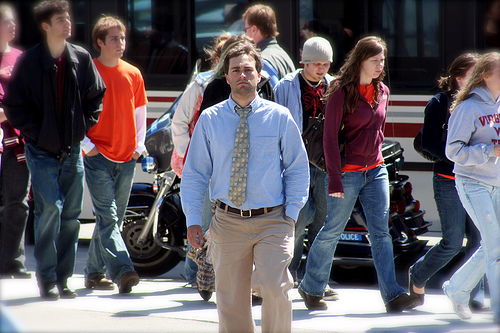
Virginia Tech, One Year Later
One year ago now came the news that two students had been shot at Virginia Tech, the school from which I’d graduated two years previous. The news was bad, but it was within the scope of comprehension – William Morva had committed a similar act the prior August. A couple of hours later, the bright red “Breaking News” banner at the top of CNN’s website reported the number as 20. This was a gaffe they’ll regret, I thought, adding a zero like that. Then ABC reported 22. Pictures of students escaping from Norris Hall began to appear. The death toll climbed, seemingly without potential limit. Reporters started to call me. It’s real.
Facebook was the only reasonable means of communication. My friends took a head count of friends, who in turn gathered head counts from their friends, the missing chased down in a flurry of phone calls and text messages. Not all of the missing were found. Graduation had flung us to the four corners of the earth, and we mourned by updating our profile pictures, grieved via 60-character status updates and came together by joining groups like “VT United” and “Always Remember Virginia Tech.” But I needed something more real.
Ted Genoways and I left for Blacksburg first thing in the morning, the 158 mile drive soothing in its familiarity. Camera in hand, I was frustrated at the photos that I was getting of the press-weary students. These people don’t look particularly sad. They’re not crying. Some are even smiling. They’re just people walking. If these people won’t look sad, then they’re not useful to me. We watched the convocation on TV, while sitting in the student center. Others in attendance busy themselves by snipping off short lengths of black ribbon from a spool, twisting them, and fastening them at their intersection. Each completed ribbon was tossed into a cardboard box, awaiting distribution. Candlelight vigils and ribbon campaigns don’t happen on their own – somebody has to buy the candles and make the ribbons. Grief finds its form.
The current issue of VQR includes a poem that’s fitting to highlight on this day. Among the 32 people killed was Jamie Bishop. A teacher of German, photographer, designer and husband, Bishop died while leading his Elementary German class. His father, two-time Nebula Award-winning author Michael Bishop, contributed “Jamie’s Hair” to VQR:
Jamie’s Hair
Michael Bishop
- He scooped it with deft, long-fingered hands and tamed it
with an elastic band, or let it hang loose on the flat bony cliff of his back.
His hair declared him his own bohemian, a middle-class free spirit
with a mortgage to pay down, a racing bike, a subscription to Netflix,
and a frau as deceptively frail as Hans Memling’s palest Madonna. - Married, he cut it but twice and only to give away.
He then looked like a soldier or a monk—though neither calling
set his mind afire as did the table saw or the digital collage.
Long again, his hair gave him a faint resemblance to the rock star
he aped at a party—“Famous Dead People”—two months before
falling into his own celebrity, if only for fourteen minutes. - Riding shotgun in a dry-ice mental fog, I carried his hair
back from the mortuary in a Ziploc freezer bag.
Later, we Googled the guidelines of the organization
to which we sent this salvaged relic of his immolated body. - Sometimes I try to picture its recipient, thinking on her world—
a purple zinnia, a swim in the bell-shaped pool, a milkshake
after chemo—but I see only his shorn head at the crematory door,
serene as a bodhisattva, soon to kindle in a fire that will never consume
our love, a fire his hair escaped to adorn the skull of someone younger—
dying, but not yet dead.

